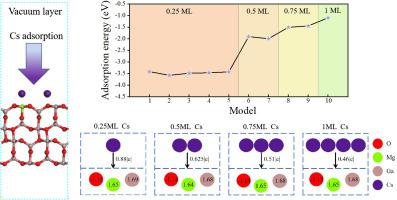掺杂mg的β-Ga2O3(100)表面Cs吸附的第一性原理研究
IF 4.7
3区 化学
Q2 CHEMISTRY, PHYSICAL
Journal of Photochemistry and Photobiology A-chemistry
Pub Date : 2025-09-18
DOI:10.1016/j.jphotochem.2025.116784
引用次数: 0
摘要
β-Ga2O3具有超宽带隙、高电子迁移率和优异的稳定性,是一种理想的日盲紫外(UV)光电阴极材料。然而,其p型表面敏化机制尚不清楚。在这项工作中,我们采用第一性原理计算系统地研究了不同的Cs吸附位点和覆盖率对mg掺杂β-Ga2O3(100)表面稳定性、电子结构和光学性质的影响。这些结果表明,对于单个Cs原子的吸附,B2位点(Mg原子和Ga原子之间的桥位)具有最高的吸附稳定性。随着Cs覆盖率的逐渐增加,吸附能增加,但仍为负,为吸附过程的稳定性提供了强有力的热力学证据。在电子结构特性方面,功函数先减小后增大,在0.5单层(ML) Cs覆盖时达到最小值。深入分析表明,随着Cs覆盖率的增加,导带最小值(CBM)和价带最大值(VBM)表现出向下的能量偏移。当覆盖率超过0.5 ML时,费米能级进入导带,表面转变为n型态。光学性能方面,Cs吸附显著增强了mg掺杂β-Ga2O3(100)表面光电阴极在日盲紫外波段的光探测能力,提高了材料在日盲紫外波段对光信号的响应效率。本文章由计算机程序翻译,如有差异,请以英文原文为准。

Study of Cs adsorption on Mg-doped β-Ga2O3(100) surface: A first-principles investigation
β-Ga2O3 is an ideal solar-blind ultraviolet (UV) photocathode material due to its ultra-wide bandgap, high electron mobility and excellent stability. However, its p-type surface sensitization mechanism remains unclear. In this work, we employ first-principles calculations to systematically investigate the effect of different Cs adsorption sites and coverages on the surface stability, electronic structure, and optical properties of the Mg-doped β-Ga2O3(100) surface. These findings demonstrate that for single Cs atom adsorption, the B2 site (bridge site between Mg atom and Ga atom) exhibits the highest adsorption stability. As the Cs coverage gradually increases, the adsorption energies increase while remaining negative, providing strong thermodynamic evidence for the stability of the adsorption process. Regarding the electronic structure characteristics, the work function initially decreases and then increases, reaching its minimum value at 0.5 monolayer (ML) Cs coverage. In-depth analysis reveals that with increasing Cs coverage, the conduction band minimum (CBM) and the valence band maximum (VBM) exhibit a downward energy shift. When the coverage exceeds 0.5 ML, the Fermi level enters the conduction band, and the surface transforms into an n-type state. In terms of optical properties, Cs adsorption significantly enhances the photodetection capability of the Mg-doped β-Ga2O3(100) surface photocathode in the solar-blind UV, improving the material's response efficiency to optical signals within the solar-blind UV band.
求助全文
通过发布文献求助,成功后即可免费获取论文全文。
去求助
来源期刊
CiteScore
7.90
自引率
7.00%
发文量
580
审稿时长
48 days
期刊介绍:
JPPA publishes the results of fundamental studies on all aspects of chemical phenomena induced by interactions between light and molecules/matter of all kinds.
All systems capable of being described at the molecular or integrated multimolecular level are appropriate for the journal. This includes all molecular chemical species as well as biomolecular, supramolecular, polymer and other macromolecular systems, as well as solid state photochemistry. In addition, the journal publishes studies of semiconductor and other photoactive organic and inorganic materials, photocatalysis (organic, inorganic, supramolecular and superconductor).
The scope includes condensed and gas phase photochemistry, as well as synchrotron radiation chemistry. A broad range of processes and techniques in photochemistry are covered such as light induced energy, electron and proton transfer; nonlinear photochemical behavior; mechanistic investigation of photochemical reactions and identification of the products of photochemical reactions; quantum yield determinations and measurements of rate constants for primary and secondary photochemical processes; steady-state and time-resolved emission, ultrafast spectroscopic methods, single molecule spectroscopy, time resolved X-ray diffraction, luminescence microscopy, and scattering spectroscopy applied to photochemistry. Papers in emerging and applied areas such as luminescent sensors, electroluminescence, solar energy conversion, atmospheric photochemistry, environmental remediation, and related photocatalytic chemistry are also welcome.

 求助内容:
求助内容: 应助结果提醒方式:
应助结果提醒方式:


